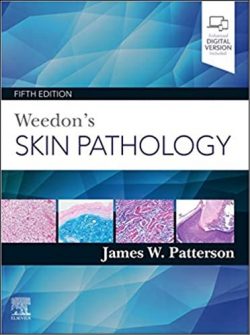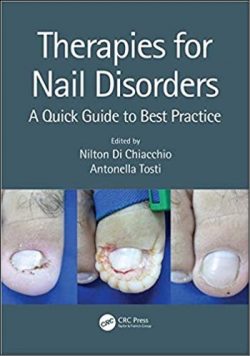Offering the reader a comprehensive look at the material regarding alopecia areata, this book is divided into several sections: One section encompasses the detailed overview of alopecia areata including its epidemiology, etiology, signs, symptoms, diagnosis, differential diagnosis and treatment options; another section provides information and content about different comorbidities in patients with alopecia areata; the third section contains case studies of patients diagnosed with alopecia areata, including their signs, symptoms, lab tests, clinical management, and treatment; and the last section covers research studies on this disease. Complete with full color photographs of patients before, during, and after the disease to accompany the various sections, Alopeacia Areata — A Clinician’s Guide is written for dermatologists as well as internists dealing with the comorbid conditions that often accompany alopecia areata.
Alopecia Areata: A Clinician’s Guide
Author: Pooya Khan Mohammad Beigi
Part 1: Overview
Chapter 1: Introduction
Part 2: Diffuse Alopecia
Chapter 2 – Diffuse alopecia areata
1. Introduction
2. Epidemiology
3. Pathophysiology
4. Diagnosis
5. Differential Diagnosis
6. Treatment
Chapter 3 – Alopecia totalis / universalis
1. Introduction
2. Epidemiology
3. Pathophysiology
4. Diagnosis
5. Treatment
Chapter 4 – Telogen effluvium
1. Introduction
2. Pathogenesis
a) Immediate anagen release
b) Delayed anagen release
c) Short anagen syndrome
d) Immediate telogen release
e) Delayed telogen release
3. Diagnosis/ Clinical Features
a) Acute telogen effluvium
b) Chronic diffuse hair loss
c) Primary chronic telogen effluvium
4. Differential Diagnosis
5. Treatment
Chapter 5 – Anagen effluvium
1. Introduction
2. Pathophysiology
3. Clinical Presentation
4. Diagnosis Investigation
5. Treatment
6. Differential Diagnosis
Chapter 6 – Loose anagen syndrome
1. Clinical Presentation
2. Hair pull test and Trichogram
3. Histopathology
4. Epidemiology
5. Pathogenesis
6. Treatment and Prognosis
7. Differential Diagnosis
Part 3: Focal Alopecia – Non-scarring Alopecias
Chapter 7 – Androgenetic alopecia (AGA)
1. Introduction
2. Epidemiology & Risk Factors
3. Pathophysiology
4. Diagnosis
5. Differential Diagnosis
6. Treatment
Chapter 8 – Alopecia areata
1. Introduction
2. Etiology
a) Molecular genetics
3. Epidemiology
4. Diagnosis/ Clinical Features
a) Clinical diagnosis
b) Clinical features
c) Nail abnormalities
d) Associated diseases
e) Biopsy
5. Differential Diagnosis
a) Tinea capitis
b) Androgenetic alopecia
c) Telogen effluvium
d) Triangular alopecia
e) Cicatricial alopecia
f) Nervous hair pulling (trichotillomania)
6. Treatment
a) First line therapies
Corticosteroid cream
Topical immunotherapy
b) Second line therapies
c) Systemic therapies
d) Treatment of children with AA
Chapter 9 – Tinea capitis
1. Introduction
2. Epidemiology
3. Clinical Presentation/ Physical findings
4. Diagnosis Workup
5. Treatment
Part 4: Focal Alopecia – Traumatic Hair Loss
Chapter 10 – Trichotillomania (hair pulling disorder)
1. Introduction
2. Epidemiology & Risk Factors
3. Pathophysiology
4. Diagnosis
5. Differential Diagnosis
6. Treatment
Chapter 11 – Traction alopecia
1. Clinical Presentation
2. Epidemiology
3. Histological Findings
4. Treatment
Part 5: Focal Alopecia – Cicatricial Alopecia
Chapter 12 – Chronic cutaneous lupus erythematosus
1. Introduction & Clinical Presentation
2. Diagnosis
3. Treatment
Chapter 13 – Lichen planopilaris
1. Introduction & Clinical Presentation
2. Pathogenesis
3. Epidemiology
4. Diagnosis
5. Biopsy/ Histopathology of LPP
6. Treatment
7. Differential Diagnosis
Chapter 14 – Central centrifugal cicatricial alopecia
1. Introduction
2. Epidemiology & Risk Factors
3. Pathophysiology
4. Diagnosis
5. Histopathology
6. Differential Diagnosis
7. Treatment
Part 6: Pathology slides
Chapter 15 – Pathology slides
Part 7: Research studies
Chapter 16 – Research study 1
Chapter 17 – Research study 2
Part 8: Case reports and photos
Chapter 18 – Patient descriptions
Pooya Khan Mohammad Beigi, MD, MSc, MPH is a Clinical Research Fellow at the University of British Columbia (Vancouver, BC, Canada). He is also the Founder/CEO of Misdiagnosis Association and Society (Seattle, WA, USA), and Founder/CEO of Father Medical Charity (Vancouver, BC, Canada).
Dr. Beigi established Misdiagnosis Association and Society (MARI), with the aim of collecting and preparing the most comprehensive database of errors in medicine and conducting related medical research studies, in collaboration with health organizations, universities, clinics, professors and physicians from all around the world.
Also, he founded Father Medical Charity with the goal of helping patients in need, especially those in underdeveloped countries. This Charity collaborates with many physicians and nurses employed in underdeveloped countries, who identify patients in need and refer them to this medical charity to receive the necessary medications or facilitate treatments for them.
Dr. Beigi has presented his research studies to several international conferences, including the 2nd BC eHealth and Innovative Technology, the Canadian Pharmacists 2015, and the 23rd World Congress of Dermatology, etc. He also has written several books for Springer including; Clinician’s Guide to Acrodermatitis Enteropathica (2015), Clinician’s Guide to Mycosis Fungoides (2016), Clinician’s Guide to Pemphigus Vulgaris (2017), Psoriasis: A Clinician’s Guide (in development), Clinician’s Guide to Vitiligo and other Hypopigmentation Disorders (in development) and Clinician’s Guide to Hyperpigmentation Disorders (in development).
Offers readers a comprehensive look at the material regarding this disorder
Includes full color photographs of patients before, during, and after the disease to accompany the various sections
Written for dermatologists as well as internists dealing with the comorbid conditions that often accompany alopecia areata
Includes case studies,epidemiology, etiology, signs, symptoms, diagnosis, differential diagnosis and treatment options





